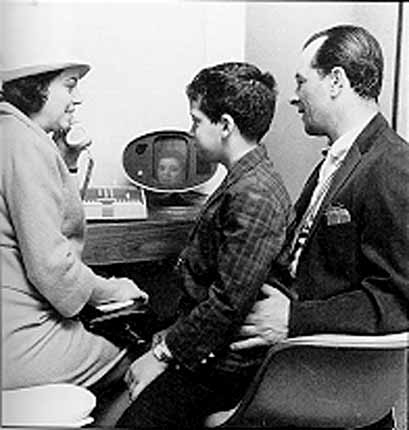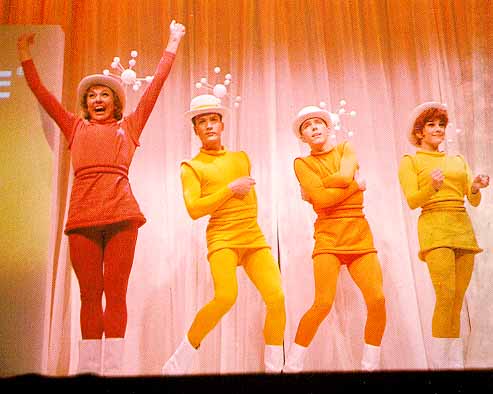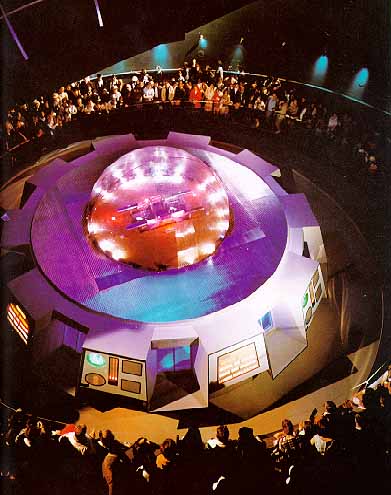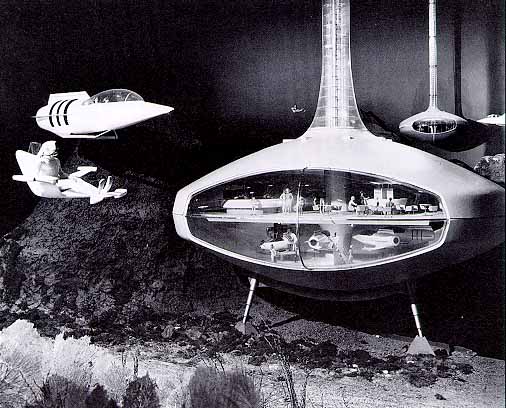Showcasing Technology at the 1964-1965 New York World's Fair
The 1964/65 New York World's Fair's twin themes "Man's Achievements in an Expanding Universe" and "A Millennium of Progress" celebrated the boundless potential of science and technology for human betterment. It was a time in America's history that it was at the very crest of its postwar (World War II) technological and economic prowess. Americans were infatuated by the space program's goal of landing a man on the moon, intrigued by the promise of a computer and information era, and pursuing a nuclear power program to provide electricity "too cheap to meter."
In many ways the exhibits at the World's Fair showcased new technological frontiers: the Space Age, the Information Age of computers and communication, the Consumer Age of new materials and products for everyday life, and the Atomic Age of electricity "too cheap to meter." The message was of optimism with little thought to environmental or sociological consequences. The purpose was to educate the public, particularly children of school age, who were thought to be far behind the Russians in mathematical and scientific skills. It was the age of Sputnik and Americans were just catching up.
The Information Age: Computers and Communications
The computer age in 1964 consisted of huge mainframe computers in air-conditioned rooms operated by technicians in white lab coats. Computers then didn't think, but they were useful for producing lists by shuffling through stored information. At the National Cash Register pavilion, people could choose a date and get a list of famous events that took place, or perhaps the essential sights of a city like Rome, Paris or London. Parker Pen's computer upon filling out a questionnaire about one's hobbies, could match you with a foreign pen pal whose name was stored in its memory. At the Better Living Center computers generated lists of colors to use in home decorating. Similar exhibits were at the Hall of Education, General Electric, Hall of Free Enterprise and Clairol's pavilion. Since computers were magic to most, they unfortunately gave the impression that they were thinking rather than shuffling data.
IBM's pavilion was different in that it attempted, through its various exhibits, to explain how computer circuits and memory cores worked, to teach the principles of probability, logical structure and abstraction, and to persuade people that computers were beneficial. While IBM knew that it couldn't sell or lease a computer to the average visitor, they did try to prove that they were not a threat but user-friendly. They used a puppet show to show that complex problems could be ultimately be reduced to the "yes/no" structure of the game of 20 questions, only longer.
IBM's wonderful presentation in its 90 foot high ellipsoidal shaped theater was a multi-media show called the "Information Machine." A twelve tier "People Wall" hydraulically lifted 500 visitors up inside the theater to watch a 15 minute show created by Charles Eames. It used 14 synchronized projectors and nine screens inside the egg. The show explained how both the human brain and the computer obtained sensory information, fed it to the brain (central processor), and through a program interpreted it to make some decision of what to do.

| Bell Telephone's Picturephone. |
New communications technologies debuted at the Fair. The Bell Telephone System pavilion introduced the Picturephone. Visitors could make a telephone call to a nearby booth and see the people talking to them as well as hear them. Other new Bell technologies included the Vocoder, touch tone phones, lasers, masers, and underseas cables using time-shared voice transmission. Visitors could make voice prints and afterwards go for a fifteen minute ride on a tour of the history of communications "From Drumbeat to Telstar."
At the RCA pavilion visitors could watch an operating color television studio. It was hooked up to 250 color monitors around the fairground. It was used for televising announcements, ceremonies, and photos of lost children.
The information exhibits proclaimed two broad themes; that rapid, globalizied communications would draw people together and breakdown barriers of misunderstanding, and that the products of the information age, including automation, would save much time and labor. It was the dawn of the information revolution and what was prophesied didn't necessarily come true.
The Space Age
America's infatuation with the Space Age was apparent at the Fair. A might array of rockets were on exhibit in the two-acre United States Space Park that was sponsored by NASA, the Defense Department and the Fair itself. The Park's exhibits included a full-scale model of the first stage (bottom stage) of the colossal Saturn V "moon rocket," a Titan II booster with its two-man Gemini capsule, and an Atlas with its Mercury capsule. At ground level, ready for the visitor's inspection, were the Mercury capsule flown on the second American manned orbital flight, and full scale models of the three-man Apollo Command and Service modules, and the Lunar Excursion Model. Unmanned spacecraft shown were replica lunar Rangers and Surveyors, a Mariner II Venus probe, Syncom, Telstar, Relay and Echo communications satellites, Explorer and Discoverer research satellites, and Tiros and Nimbus weather satellites.

| U.S. Space Park. |
In the Hall of Education, next to Space Park, were multi-media space exhibits. In a show sponsored by Martin Marietta 400 visitors at a time watched two full-sized space vehicles "Rendezvous in Space" high overhead. And inside the 96 foot diameter Moon Dome (its exterior had a plastic relief map of the moon) in the Transportation and Travel pavilion, audiences were encircled by a Cinerama screen showing "To the Moon and Beyond."
The United States or Federal pavilion included displays of the nation's manned space program, the use of satellites for detecting weapons, and the 1962 Mariner mission to Venus. Its ride "The Past as Prologue" climaxed with a spectacular stop in space. Many other state pavilions, who had aerospace companies, mounted exhibits on communications satellites, space capsules, space history, and the search for extraterrestrial life.
Several companies involved in space research included material on the space program. Chrysler, a manufacturer of space boosters, featured a ten-story tall rocket. General Motor's Avenue of Progress included a "Space Age Research" theme center. It featured a solar space mirror, the world's largest cosmic ray spark chamber, an articulated lunar vehicle, and exhibits on space navigation technologies. Ford's "Magic Skyway" ride ended with a glimpse of man's future in space.
Even the Fair's Unisphere with its three satellite orbit rings, symbolized the human emergence into space. Viewed from the edge of the pool, the Unisphere had the dimensions Earth would have if viewed from a height of 6000 miles. Nearby sculptures, "The Rocket Thrower: and "Forms in Space" were symbols of the Space Age.
The Consumer Age: New Materials and Products for Everyday Life
As at most world's fairs, companies displayed the latest technological products and materials. It was a paradise for shoppers, gadgeteers and homemakers. Many of the new products for home, car and office, whether miracle fabrics like Dupont's Corfam, or new construction materials, they were all made of new plastics or other synthetic polymers.
The chemical science and engineering behind these developments were demonstrated in the Du Pont pavilion. Its show "Wonderful World of Chemistry" was a musical that included numbers like "The Happy Plastic Family." Everything in the theater was made of Dupont plastics; Nylon carpets, Tedlar roof, Antron and Fabrilite seat fabrics, Mylar stage curtains and Delrin doorknobs.

| Dupont's Wonderful World of Chemistry musical. |
Dupont also had a Mr. Wizard style show called "Chemical Magic" which illustrated the physical properties and processes that made the new materials possible. Rubber balls were frozen in liquid freon and shattered when dropped. Liquid luminescent dyes changed color with each pouring, and "thixotropic" substances alternately gelled and liquefied. It demonstrated how no-drip paint worked. The chemists even showed how nylon was manufactured in a test tube.
Exotic material technologies were shown at General Motors, Ford, the Hall of Science and half a dozen other pavilions. These included glass-plastic hybrids, ceramic sponges, metallic ceramics and coatings, self-lubricating parts, solid state and thermoelectric devices.
The parade of futuristic goods for the home was mind-boggling. One could visit a Gallery of Kitchens and a Crystal Palace of Fashion in the huge Better Living Center, a Promenade of Interiors, a Formica World's Fair House, and more. One of the most interesting kitchen gadgets was in the futuristic Norge Kitchen in the Festival of Gas pavilion. The Norge Dish Maker ground, washed and dried the family's plastic dinnerware and molded the pellets into new plates, cups and saucers.
The Atomic Age: Electricity Too Cheap to Meter
During the Fair the atomic age meant nuclear power. The message was that soon a flood of energy from fission and fusion reactors would lift humanity's standard of living to utopian levels. What was ignored were issues of the dangers of atomic weapons and accidental exposure to radiation.
The most grandiose science experiment at the Fair was at the GE Progressland pavilion whose themes were "Progress through Electric Power" and "The Wonders of Atomic Energy." After visitors exited Disney's Carousel of Progress a moving Time Tube brought them to the "Skydome Spectacular" to experience electricity's future. There, using the pavilion's two hundred feet wide and eighty feet high dome as a screen, the visitor saw and felt the immense power of lightning, storms, and solar energy (thermonuclear fusion).
A spiral downramp lead visitors to a large well at the center of the pavilion where they watched "the creation of a miniature sun." A big Lexan dome surrounded the apparatus. Inside were two three-foot-long quartz tubes filled with deuterium plasma, Inside them, after a three minute countdown, a million amperes of current created a magnetic field 200,000 times stronger than the earth's. And inside this invisible bottle, millions of deuterium nuclei fused at a temperature of 100 million degrees for six millionths of a second. Those watching saw a tremendous flash accompanied by a loud bang that signified the birth of a new age. The experiment implied that in less than two decades man would have an almost cheap limitless source of electrical energy, enough to last for billions of years.

| General Electric demonstrated the principles of fusion. |
The U.S. Atomic Energy Commission had rejected a Fair proposal to build and operate a mobile nuclear fission plant at the Fair. Instead they choose to contribute an Atomsville USA exhibit at the Hall of Science pavilion where people could try out remote "hot cell" manipulators for handling radioactive materials and run a simulated reactor. This exhibit and one sponsored by the U.S. Office of Civil Defense, discussed the fallout bomb shelter program.
Integrated Visions of the Technological Future
There were several exhibits at the Fair that envisioned a macro-engineered future using the latest technological developments. The Hall of Science featured "A journey into Space", there was "Space City" on Ford's Magic Skyway, and of course General Motors imaginative "Futurama." All offered cities of the future, sterile cities of soaring skyscrapers with huge underground parking garages connected to other places and each other by elevated or tunneled highways each carrying thousands of computer guided vehicles. They were cities designed for machines, not for people. The buildings were alive with workers or people who lived there, but the city was dead, its streets deserted.

| Futurama's City of the Future. |
General Motors' Futurama exhibit showed more than just terrestrial cities of the future. Its exhibits envisioned a city 10,000 feet underseas reached by atomic submarines. It would be a working city where men operating claw-handled "aquacopters" would mine minerals and ores, and others would drill of gas and oil or farm the sea. There would even be an underwater resort, Hotel Atlantis.

| Futurama's Underseas city. |
Futurama envisioned a lunar colony with articulated all-terrain crawlers for expeditions, and an orbiting station shielded from radiation. It pictured in the Antarctica, an artificial port piercing the ice-shelf. Ice excavators would build an underground global weather forecasting center. The desert would be salvageable and automated desert farming would be feasible with irrigation by desalinated seawater. In each case the designers hoped to conquer barren useless land to make them productive.
Futurama's designers became carried away with a design of a three-football-field long, five-story-high atomic powered jungle road builder. They envisioned that it could make one mile of elevated four-lane highway each hour, twenty-four hours per day. A 100 foot long insectiform laser tree cutter preceded the road builder, and it sprayed the cleared areas with chemicals to retard growth. While projects like this were well thought out, it was long before environmentalists thought of the consequences. In this case it would have destroyed the rain forest environment and changed global weather patterns. As to the other projects, they too would have destroyed the environment if they had gone beyond the experimental stage and became massive projects involving hundreds or even thousands of square miles.